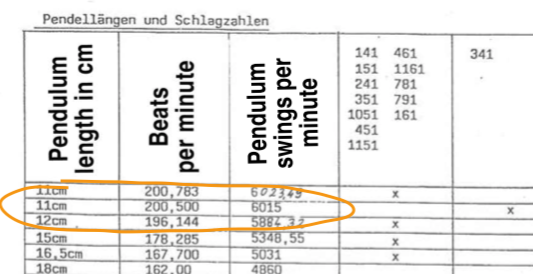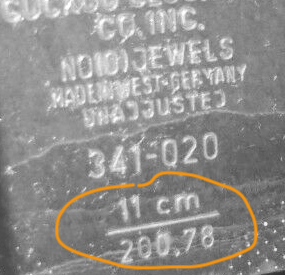

source: Cousins
Published beat tables and back plate stamps on some movements may show a Beats Per Minute (BPM) number. To be of any use for the purposes of timing, such BPM value has to be specified with at least 3 decimal places. For the case of Beats Per Hour (BPH) — at least 2 decimal places. Depending on the beat rate number, the tenths of a BPH value could account for loss of precision up to ±12 S/D, and the hundreds of ±1.2 S/D.
Some sources only provide a whole number BPH, and often this is not even the rounded value, but merely the truncated integer part, for example 4246.62 becomes 4246! Whenever possible, use the numbers with more decimals specified, otherwise results may not be precise. Here is a precision loss calculator that estimates the worst case for a given beat rate.
Consider for example the FHS Hermle movement 341 with 11 cm pendulum. Some documents, such as the "Pendellängen und Schlagzahlen" table, list the BPM as 200.500 which resolves to exactly 12030 BPH. In reality, a few different back plate stamps can be found, typically 200.8 or 200.78, which is more like the other 11 cm models such as 141, 151 etc.


source: Cousins
Let's do a "virtual" train count without having the actual wheels. A quick Google search for "341 11 escape wheel" and similar reveals the following information:
56 Teeth Center wheel,
source: perrinwatchparts.com
44:8 Third wheel,
source: cmi-hermle.com
Possibly 50 Teeth Fourth wheel? In this listing no teeth or pinion information is given, so we try to count the teeth with the hope that this is a picture of the actual wheel.
source: perrinwatchparts.com
25:8 Escape wheel,
source: perrinwatchparts.com
BFGGT is an in-house software that cycles through wheels and trains combinations. It searches for matches based on user-provided hints such as an approximate BPH and known center and escape wheels. For the criteria above, only two matching trains are found. Ruling out the unlikely 75:12 wheel, we can confirm that the fourth wheel is indeed 50:8 *
Even if your clock keeps perfect time, when timed against the target rate from the OEM table, the result will be +9 S/D fast. And if you decide to use the back plate number instead, you end up with a -120.3 S/D error!
We use the method described here to validate and adjust OEM beat rates before adding to the database. Such records are marked as "adjusted".